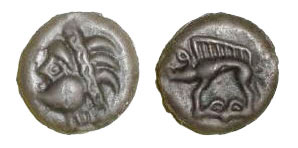Settlement types - urbanisation and the barbarian economy
7.2 Coinage

The first coins in central and western Europe probably would have entered central Europe as payments to the Celtic mercenaries. Rather than have a set value, coins were likely first used as prestige gifts and for reusable precious metal. There is no way of knowing how many Macedonian gold staters were melted down to produce works of ‘Celtic art’!
When mercenaries were no longer being used in other parts of the world, the payments would have stopped, and it is perhaps the reason why from about 200 BC, coins were being struck in the Celtic world. They were loosely modelled on Aegean coins, especially Macedonian coins of Phillip II, with a crowned head on the obverse and a horse or other symbol of strength on the reverse. They were made of cast gold or silver and set into blanks; then the images were struck with dies. If you would like to learn more about this process, read the article Celtic Copper Alloy Coin Minting Technology.
After contact with Rome, Gaulish and British coins of the 1st century BC also use Latin letters to indicate the leader responsible for the minting. At this point base metal – copper alloy – coinage also comes into use. These would have probably served for low-value exchange.
Group activity: Celtic coins
We touched briefly on coins as a medium for art in Unit 5. Read about the significance of Celtic coinage on the Journal of Ancient Numismatics Britain's First Coins page.
- How did coinage impact the way people conducted their daily interactions?
- What do you think the introduction of coinage can suggest about power, prestige and the economy?
Discuss in the Urbanisation forum.